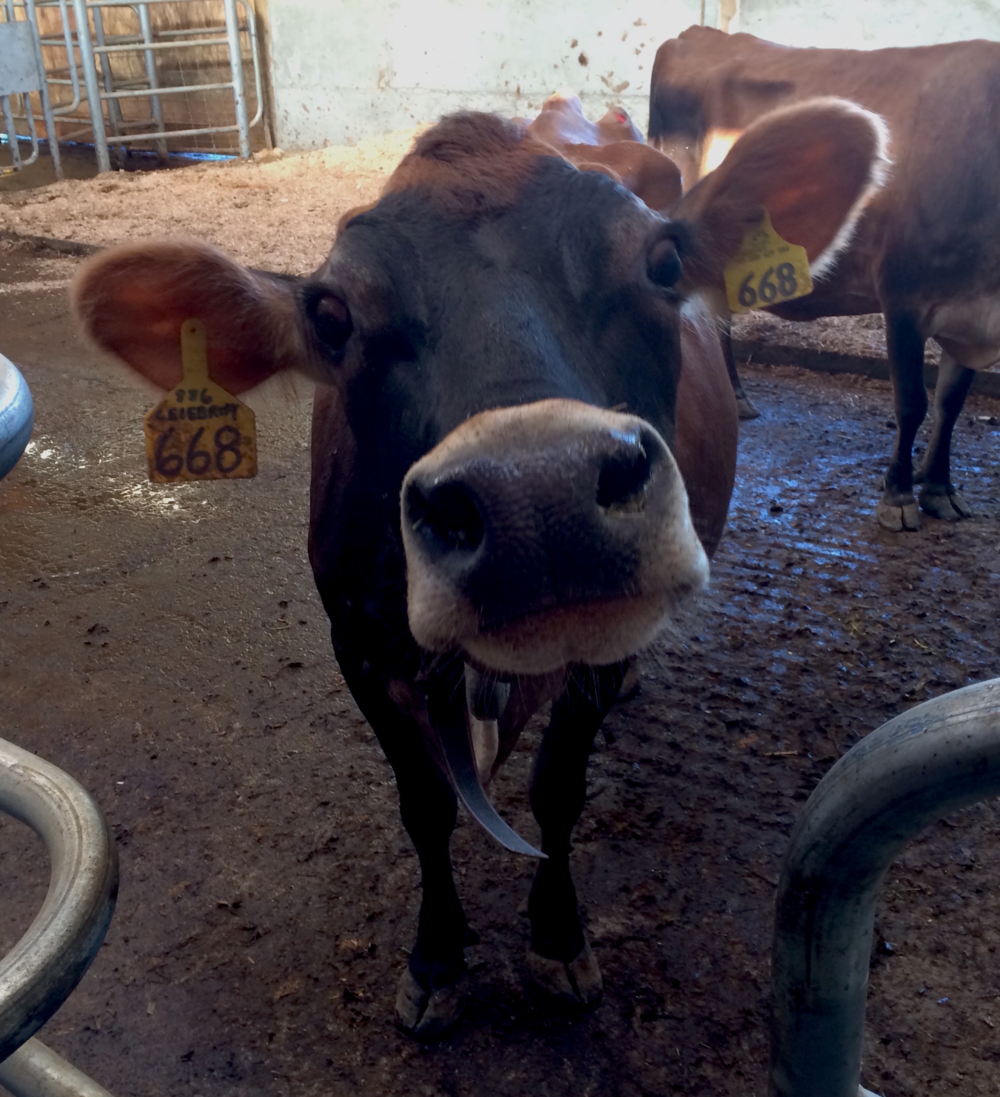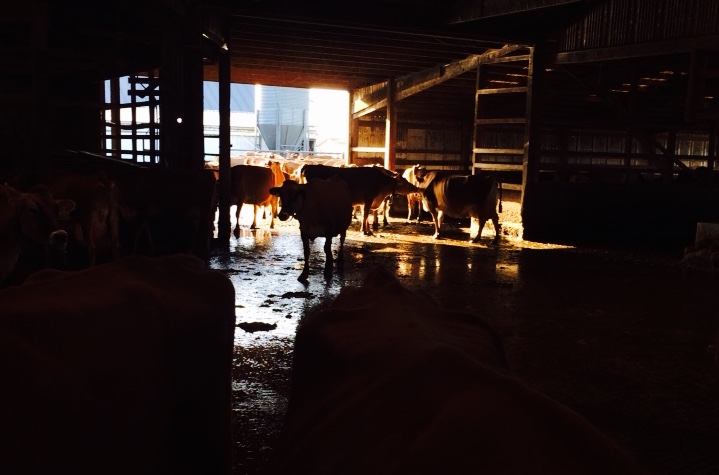The Future of the Small Dairy

Cows are curious. Twin Brook Creamery, Lynden, WA. Photo by William Dixon, 2015.
A few months ago, I witnessed the hopeful and compassionate future of the small dairy in the United States.
I took a trip to Twin Brook Creamery, an idyllic dairy farm in northern Washington not far from the Canadian border, where I met Larry Stap and his herd of 170 Jersey cows. I was interested in touring his operation because quality ingredients are important to us at Bellflower: his milk products are delicious and I wanted to know how he produced such great milk.
When I arrived, the farmer warmly greeted me and we began the tour. There was the expected modest pasteurizing plant associated with the bottling plant. All of this was under a set of small, connected sheds. It was automated, but there were at least five workers in sanitary jump suits attending to the various aging machines. The milk itself was going into real glass bottles, which, one could argue, is a step into the past, not the future. But the farmer’s distributors made every effort to obtain the empty bottles from consumers for reuse back at the farm.
“Between 1970 and 2006, the number of farms with dairy cows fell steadily and sharply, from 648,000 operations in 1970 to 75,000 in 2006, or 88 percent (fig. 1). Total dairy cows fell from 12 million in 1970 to 9.1 million in 2006, so the average herd size rose from just 19 cows per farm in 1970 to 120 cows in 2006.1 Moreover, because milk production per cow doubled between 1970 and 2006 (from 9,751 to 19,951 pounds per year), total milk production rose, and average milk production per farm increased twelvefold.”

A beautiful bovine at Twin Brook Creamery, Lynden, WA. Photo by William Dixon, 2015.
The farmer was anxious for me to meet his “girls” so we took a short drive from the bottling facility to where the cows are milked. The farm buildings, surrounded by flat hay fields, looked pretty standard – a wood frame house, a big cow shed with a corrugated metal roof, another barn for storing hay (perhaps alfalfa), another shed to house the temporary milk storage tanks. We drove around the corner of the main shed, stopping at a dark blue metal storage tank about forty feet in diameter and towering some thirty feet above us. This, it turned out, was the heart the farmer’s waste-to-food-to-milk management process. He had balanced the size of his herd to match his land’s ability to produce food and make use of the nutrients in his copious amounts of bovine manure. This saves money he would otherwise spend on nitrogen fertilizer to enrich the soil. Nitrogen fertilizer, as it turns out, is made using vast amounts of natural gas. He also gestured to a stream that ran along the edge of one part of his property. He had taken advantage of funds from the state to create a buffer zone of native plants along the banks of the stream to protect the spawning salmon that returned there each year. As someone who thinks often about the health of our waterways, I was very impressed by this man’s operation. And you could sense his pride in how he saw his role in protecting “The Creation,” as he put it.
But with a solid sense of showmanship, the farmer saved the most impressive part of the tour for last: the cows, their beautiful caramel brown coats burnished with small blazes of white. Their huge eyes looking right into me as if to say, “Are you worthy of my labors to deliver to you one of the most iconic and wholesome beverages in history: pure cow’s milk?” They seemed very happy standing around in the shed waiting to be milked.
Except that, due to modern agriculture technology, they don’t have to wait.
Each cow has its own heifer “Fit Bit” if you will, hanging around its neck that communicates with robotic milking machines. By walking over to the machine, sensors communicate between the cow and the machine, indicating when they are ready for milking, which varies widely from cow to cow. Imagine a machine, a low-slung robot over which the cow stands, that not only milks a cow, but knows in advance when they're ready. It gives them a little treat when they step into the milking station, gently cleans their teats (which the cows seem to enjoy and helps reduce the risk of milk contamination) , checks their vital signs, keeps a precise record of their individual health and even knows when they need a 60-day break from milk production. And one of the keys to all of this?
This is cow-centered design, a system customized for bovines. Larry has three such Danish-built robots operating at this farm and not only do they milk the cows, they also supply all the forecasting and production data the farmer needs to efficiently run his business. Was anyone milking the cows by hand? No, that person had been re-assigned to do other work, but still on staff. And the whole modest (by modern farm standards) operation is making money.

Dairy workers at Twin Brook Creamery, Lynden, WA. Photo by William Dixon, 2015.
As I was driving back to Seattle, I pondered what I had seen that day. It was great to know that with the right investments in technology and a vision for the future of his land and his cows, a small dairyman had found a way to prosper. It gave me a tremendous sense of hope for the future of agriculture in our country.

Cows in the barn at Twin Brook Creamery, Lynden, WA. Photo by William Dixon, 2015.